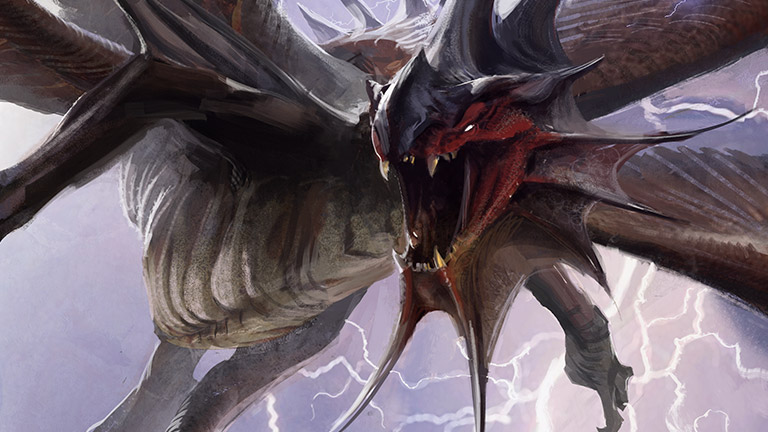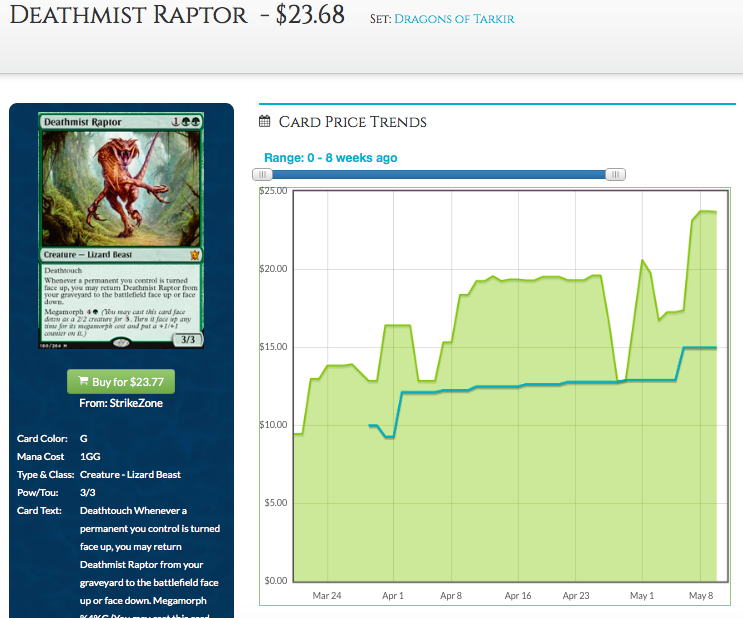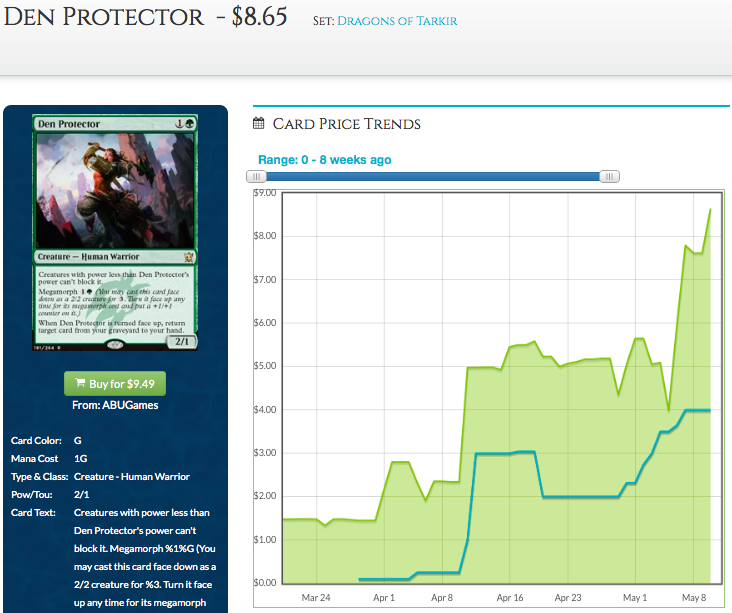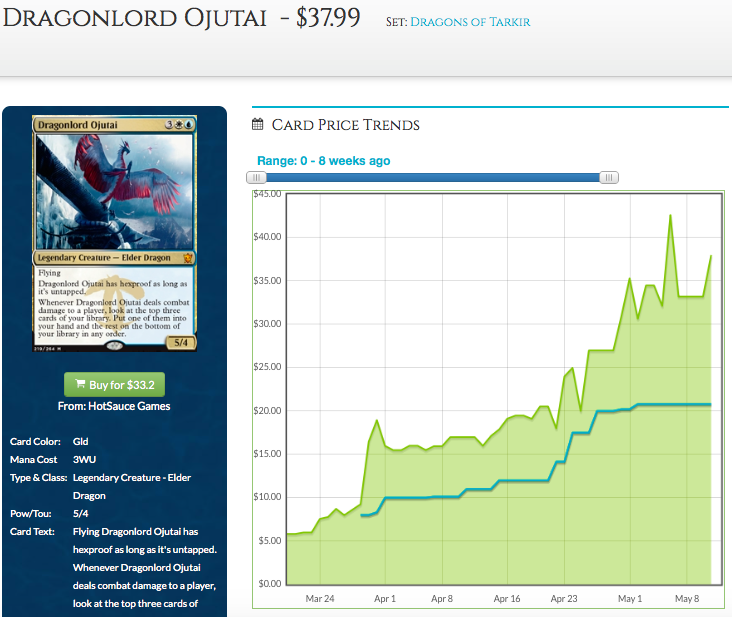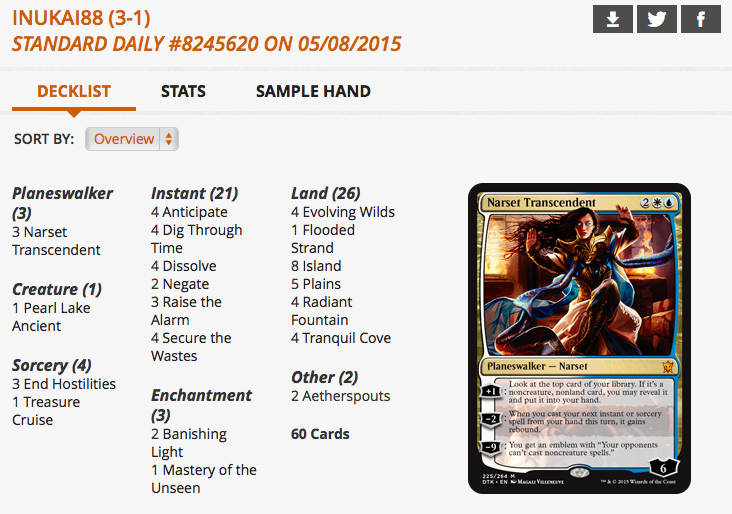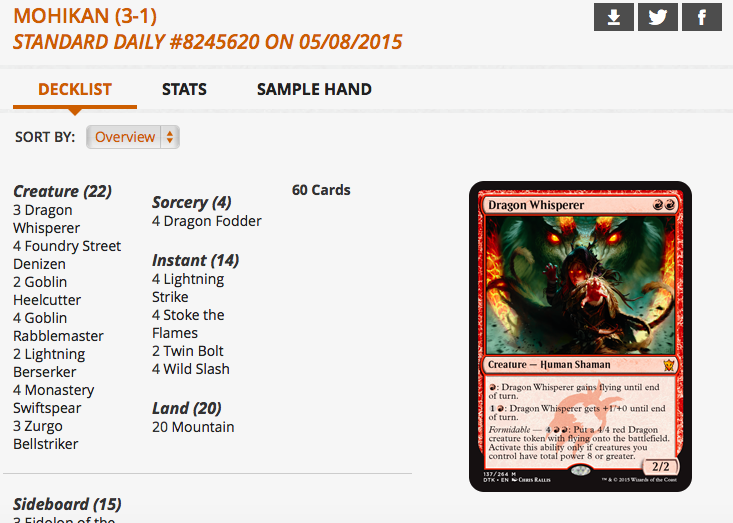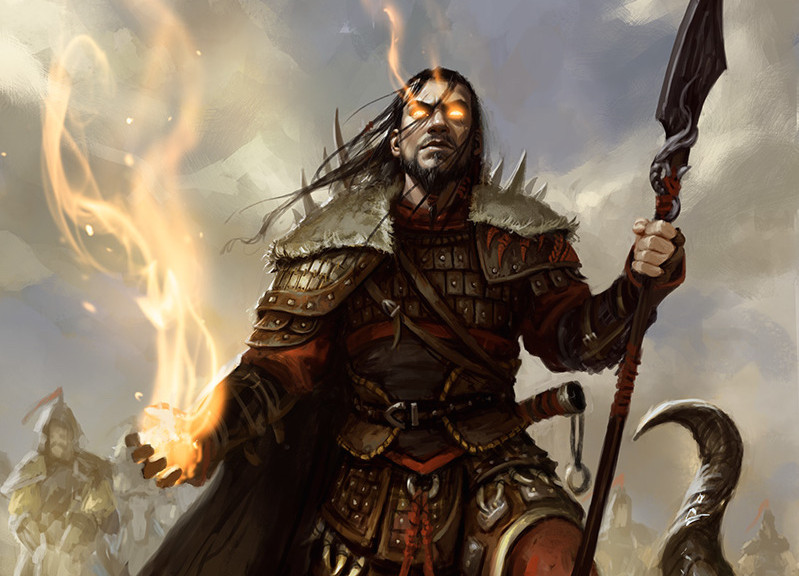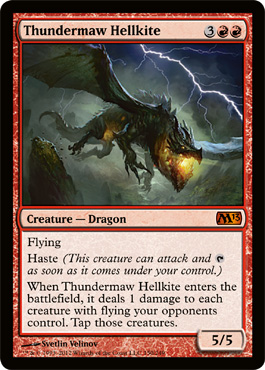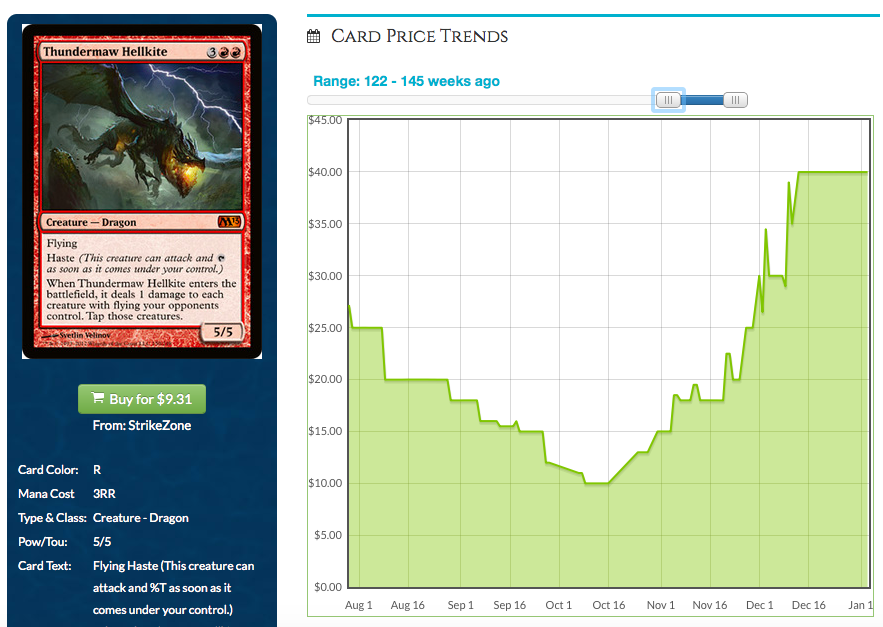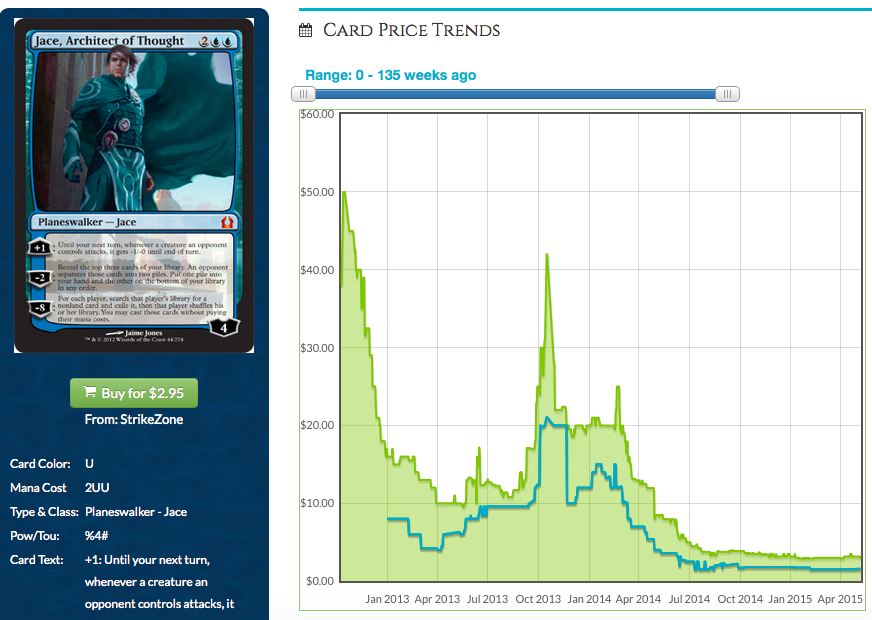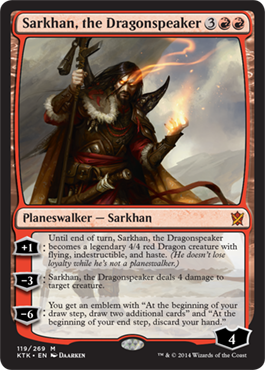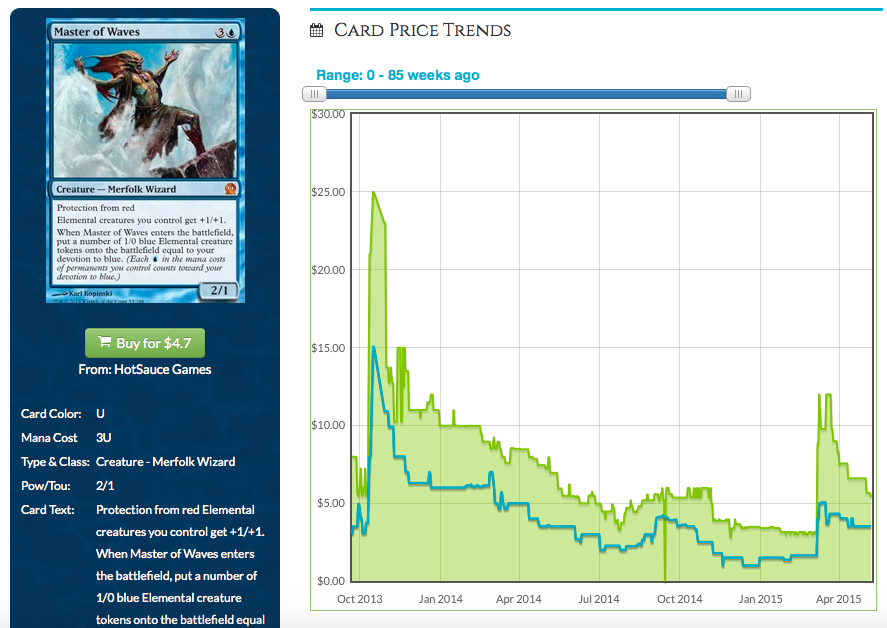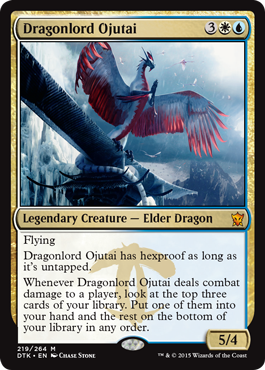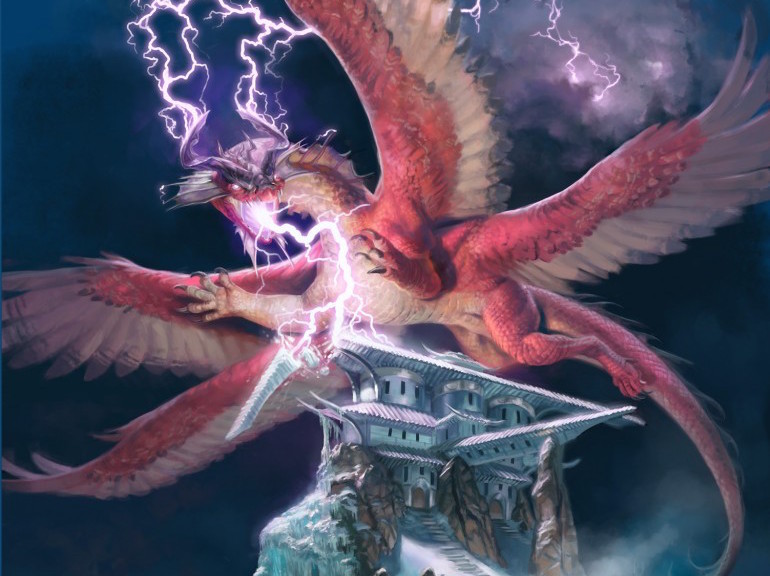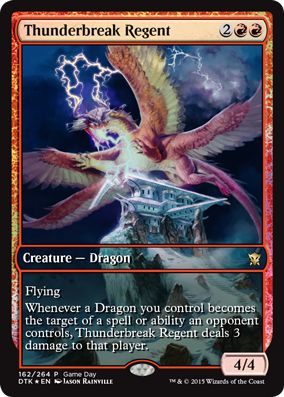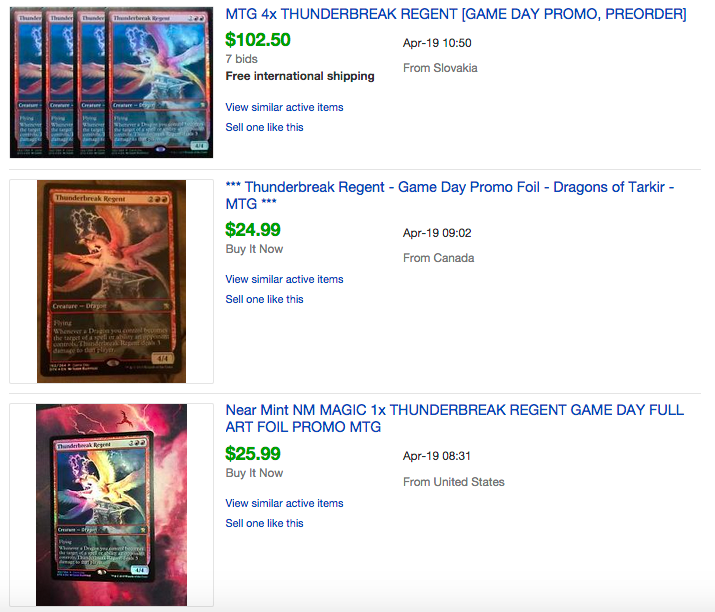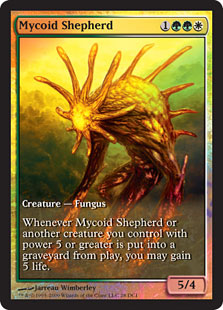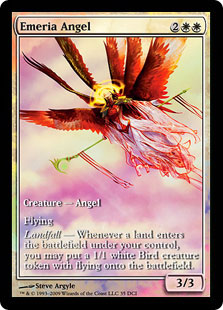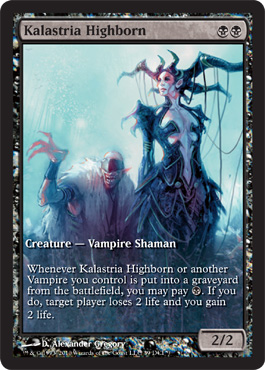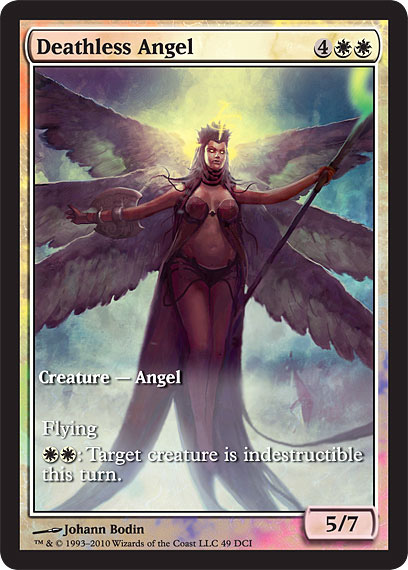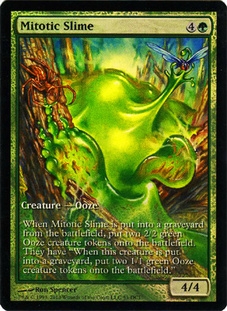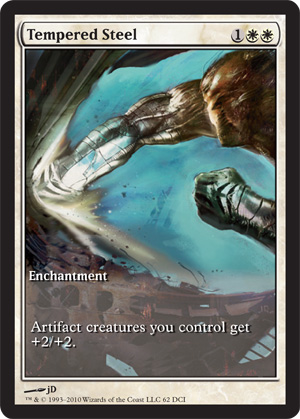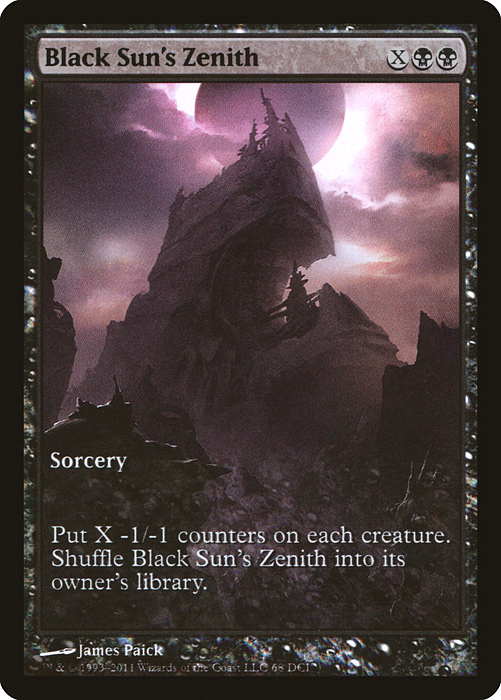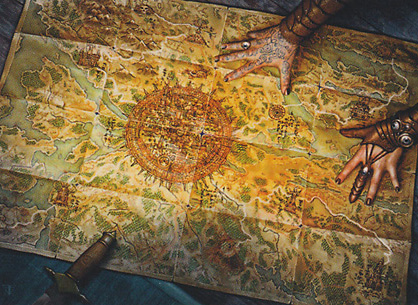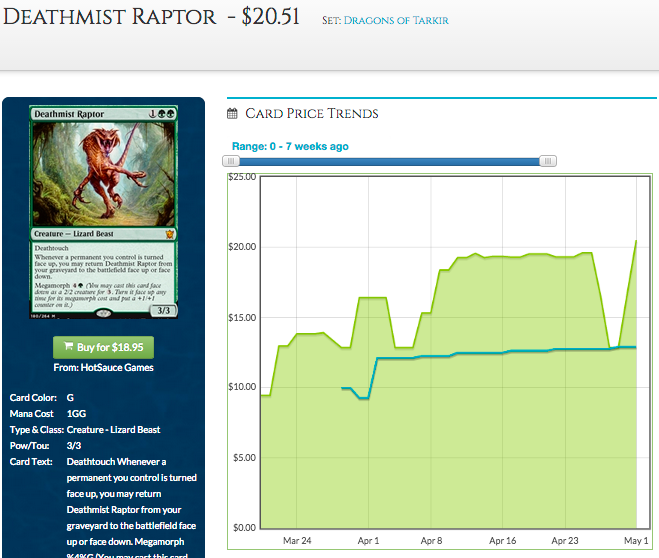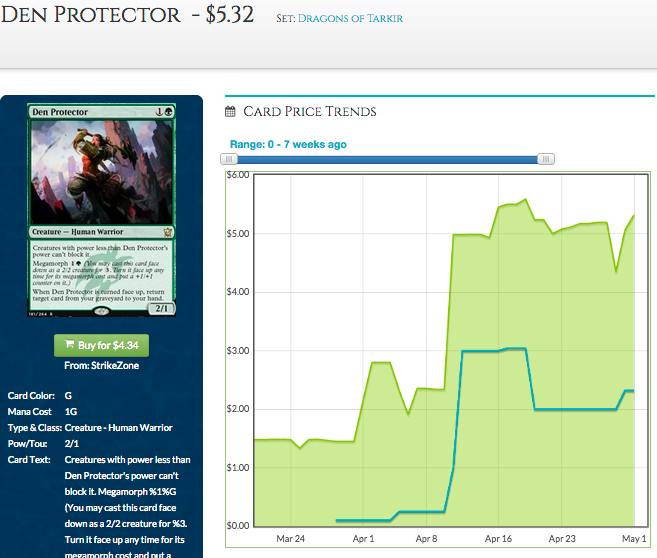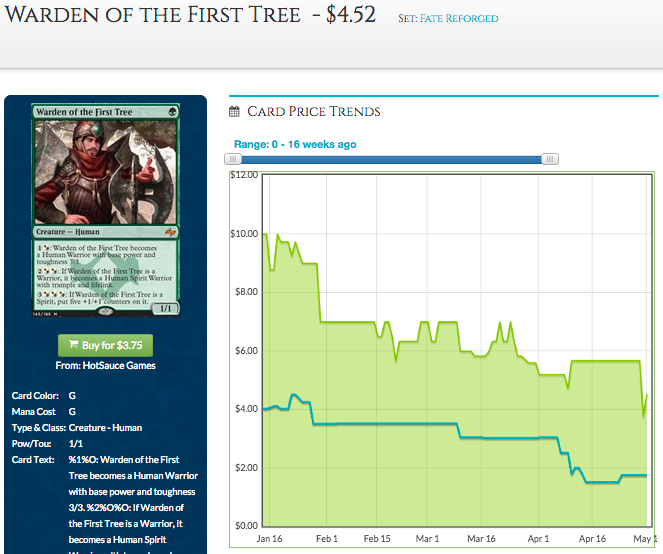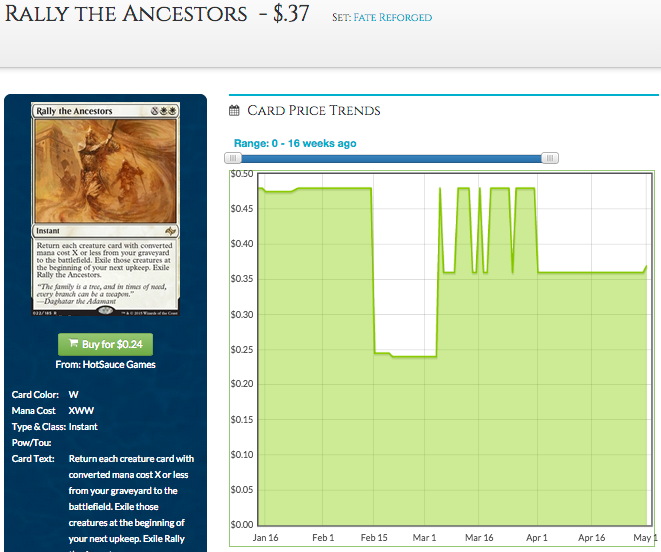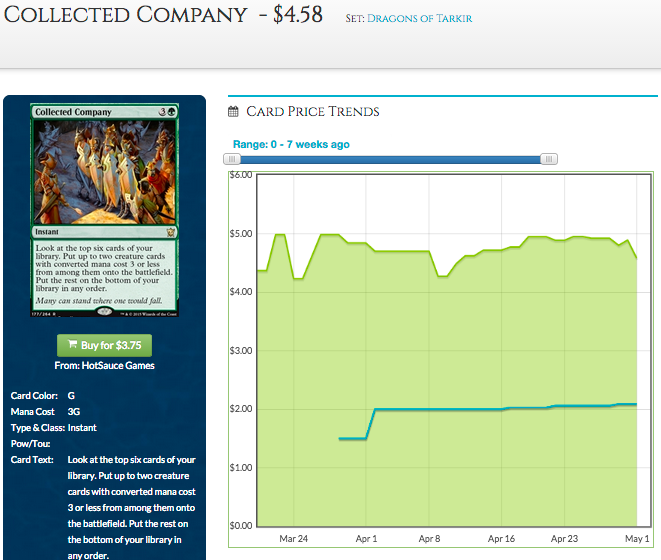By: Guo Heng
Welcome to the second instalment of The Meta Report, a weekly column dedicated to analysing the evolution of the metagame and the financial implications that result from it. This week we will be looking at both paper results (IRL) and Magic Online (MTGO) results. The previous weekend saw two Standard Grand Prix – Sao Paulo and Toronto – with a starkly different metagame in the top 8, and StarCityGames Open Portland. Grand Prix Paris took place last weekend with a top 8 that resembled that of Toronto. We would also look at 307 decks from the MTGO daily events which took place over the past week.
Before we begin, let’s review last week’s calls and see how they have performed.
Last Week’s Calls
Deathmist Raptor – Last Week: Hold; This Week: Sell
After a stellar showing at Grand Prix Toronto last week, with half the top 8 running a full four copies of Deathmist Raptor, the mighty morphing dinosaur’s price hiked from $20.51 to $23.68. My call for the raptor this week would be a sell call. With the Dragonlords taking up a large chunk of the set’s value, I suspect $24 is pretty close to the ceiling for Deathmist Raptor. On top of that, the first wave of Dragons of Tarkir redemption will be processed this Wednesday and would start hitting the market next week. Deathmist Raptor’s current spread is 37%.
Den Protector – Last Week: Sell; This Week: Sell
Den Protector grew more than I expected when I put a sell call on it last week. If Deathmist Raptor’s showing at Grand Prix Toronto was stellar, Den Protector’s was interstellar. There were 25 Den Protectors in the top 8 of the Grand Prix an as a result Den Protector’s price grew from $5.32 to $8.65.
My sell call on Den Protector last week was made based on conservative decision making. While Den Protector was seeing a lot of play in Standard, I was not confident that her price could grow further as she staple she may be, she nevertheless remains a single-format rare. With redemption coming in two weeks (as of last week’s article), Den Protector would be hard-pressed to maintain her price of $5.32 amid the other high value cards in the set and the line of play with the lower risk would be to sell at $5.32.
While my prediction that the meta would shift towards more Den Protector due to megamorph synergy’s favorable position in the metagame came true, I was wrong about Den Protector’s price trajectory. I did not foresee that Den Protector would be that prevalent.
Now at $8.65, I am going to put another sell call on Den Protector. I’d be damned if she breaks $10 even after the influx of supply from redemption.
Collected Company – Last Week: Hold; This Week: Sell
Collected Company spiked over the weekend when Yohan Dudongon brought a sweet four-color Collected Company brew to 9-0 at Grand Prix Paris and narrowly missed the top 8 by a single win. Collected Company is now sitting at a TCG-mid of $9.75. If you are holding on to any copies, now would be the right time to sell. Again, with redemption hitting the market next week, $10 is probably the ceiling for Collected Company.
Now lets get to the juicy stuff.
The Three Large Events from the Previous Weekend
| Grand Prix Toronto | Grand Prix Sao Paulo | SCG Portland | IRL Total | |
|---|---|---|---|---|
| Abzan Aggro | 1 | 2 | 3 | 6 |
| Esper Dragons | 2 | 1 | 3 | |
| Ojutai Bant Megamorph | 2 | 2 | ||
| Abzan Control | 2 | 2 | ||
| Atarka Red (Tokens) | 1 | 1 | 2 | |
| Esper Dragons Mentor | 1 | 1 | ||
| Sidisi Whip Megamorph | 1 | 1 | ||
| Abzan Megamorph | 1 | 1 | ||
| UG Collected Devotion | 1 | 1 | ||
| Mono Green Aggro Megamorph | 1 | 1 | ||
| RG Dragons | 1 | 1 | ||
| Mardu Dragons | 1 | 1 | ||
| GW Aggro w/ Megamorph & Collected Company | 1 | 1 | ||
| GR Devotion | 1 | 1 |
I’ve separated Grand Prix Paris from the three major events which took place on the previous week as Paris occurred one week later and its metagame could be a reaction to the metagame in the three events.
The most successful deck from the previous weekend was Abzan Aggro, appearing in all three events’ top 8. As Abzan Aggro is a relatively old archetype, it’s dominance has little implication on the price of its components. It was the third most played archetype in the RPTQ top 8s in the week before.
Esper Dragons was the second most successful deck, and while the table showed the total number of Esper Dragons to be three, the real number is four. I’ve separated Ricardo Nunes Martins’ innovative build of Esper Dragons which sported four Monastery Mentors. Ricardo’s take on Esper Dragons looks enticing, but it may be a one hit wonder as no one else was able to replicate Ricardo’s success with the deck. It only appeared once in the MTGO daily events in the week that followed the deck’s debut.
The centrepiece of Esper Dragons, Dragonlord Ojutai, is currently perching at a height of $37.99, after another spike.
Definitely sell your extra Dragonlord Ojutai now.
The top 8 at both Grand Prix Sao Paulo and Toronto contained a starkly different metagame, with the Toronto top 8 revolving around the megamorph synergy while the Sao Paulo top 8 resembled that of the previous weeks. The megamorph synergy was touted as the most efficient way to beat Esper Dragons, which may explain the prevalence of Den Protector and Deathmist Raptor.
Grand Prix Paris Last Weekend
Den Protector was still popular at Grand Prix Paris last weekend, with 19 copies of it in the top 8.
| Mono Red | 2 |
|---|---|
| Abzan Aggro | 2 |
| Abzan Control | 1 |
| GW Collected Megamorph | 1 |
| RG Devotion | 1 |
| Abzan Megamorph | 1 |
Although the top 8 consisted of six different archetypes, Den Protector was found in five of them (the only deck that did not run Den Protector was Mono Red). Two of those archetypes, Abzan Aggro and GR Devotion only had Den Protector in their sideboard.
There were only 11 Deathmist Raptors in the top 8, a slight dip from the previous weekend’s Grand Prix Toronto where 16 Deathmist Raptors were prowling the top 8.
Even though the megamorph duo are still exerting their grip on the metagame, I have place a sell call on both of them as it is likely that the both of them have already hit their ceiling, and with redemption hitting the market next week, it is unlikely to see them make any significant gains. Especially Den Protector.
Magic Online Daily Events 2 May – 8 May
Let’s take a look at the metagame from last week’s MTGO daily events to see if we could spot new developments to combat the megamorph threat and at the same time keep Esper Dragons, Mono Red and Abzan Aggro in check.
| MTGO Total | |
|---|---|
| Abzan Aggro | 33 |
| Esper Dragons | 32 |
| Mono Red | 32 |
| Abzan Control | 28 |
| Atarka Red (Tokens) | 28 |
| Mardu Dragons | 21 |
| GW Aggro w/ Megamorph & Collected Company | 16 |
| Ojutai Bant Megamorph | 10 |
| RG Dragons | 10 |
| Abzan Megamorph | 7 |
| Temur Midrange/Superfriends | 7 |
| GW Aggro w/ Megamorph | 6 |
| GW Aggro w/ Collected Company | 6 |
| GR Devotion | 6 |
| Jeskai Tokens | 6 |
| Esper Dragons Narset | 5 |
| Mardu Midrange | 5 |
| Mono Black Aggro | 4 |
| GW Devotion | 4 |
| UB Dragons | 3 |
| UW Control | 3 |
| Sidisi Whip Megamorph | 3 |
| UR Burn w/ Atarka's Command | 3 |
| RB Dragons | 3 |
| Bant Heroic | 3 |
| UW Dragons | 2 |
| UB Control Adrian | 2 |
| Abzan Reanimator | 2 |
| RB Aggro | 2 |
| Temur Dragons | 2 |
| Esper Dragons Mentor | 1 |
| 4 Color Dragons | 1 |
| Sidisi Whip | 1 |
| Abzan Splash Ojutai | 1 |
| UG Collected Devotion | 1 |
| UR Artifact Aggro | 1 |
| Mono White Aggro | 1 |
| Mono Green Aggro Megamorph | 1 |
| Mono Green Aggro | 1 |
| RB Dragons w/ Dragon Whisperer | 1 |
| RB Reanimator (Swift Hellkite) | 1 |
| GW Heroic | 1 |
| Red Devotion | 1 |
| BW Warriors | 1 |
| Jeskai Aggro | 1 |
| Jeskai Superfriends | 1 |
| Temur Aggro | 1 |
| Naya Dragons | 1 |
| Naya Aggro | 1 |
As we can see, the top five most popular decks in the MTGO daily events last week were the usual suspects. However, a relatively new archetype gained ground in the metagame and secured the sixth spot on the list. Mardu Dragons has been around as a fringe archetype or simply as Black-Red Dragons which posted a few results in the RPTQs, but it was Edgar Magalhaes piloting Mardu Dragons to the finals of Grand Prix Toronto that popularised the archetype.
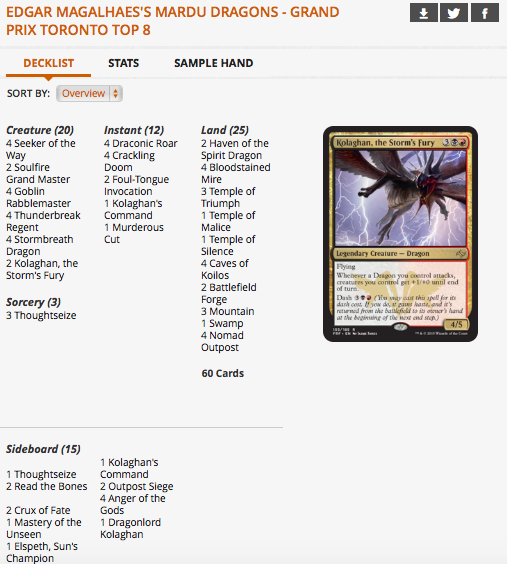
The current incarnation of Mardu Dragons is pretty much the aggressive Black-Red Dragons shell with Crackling Doom, Seeker of the Way and Soulfire Grandmaster added. Mardu Dragons is designed to combat the top dogs of the metagame. A combination of Crackling Doom and Foul-Tongue Invocation means you are unlikely to die to Dragonlord Ojutai which Esper Dragons leans on heavily to win. Seeker of the Way and Soulfire Grandmaster provide enough life gain for you to survive the early game against Mono Red or Atarka Red. A playset of Anger of the Gods in the sideboard ensures that dead dinosaurs remain dead. Stormbreath Dragon is the best card to play against Abzan Aggro and this deck runs four copies of it.
While Mardu Dragons is theoretically very well-positioned in the metagame, the deck was absent from last weekend’s Grand Prix Paris top 8 and there was only a single copy in the top 16. Nevertheless the archetype is a relatively new one, and it may take a while for its prowess to be felt.
Unfortunately, the financial implications of Mardu Dragons being propelled to tier one is limited. The deck’s key cards comprise mostly of cards from old sets whose price has settled. Dragonlord Kolaghan was only present as a singleton in the sideboard.
Other notable new developments include a few Blue-White Control lists running Narset Transcendent together with Secure the Wastes.
Narset has dropped from her high $30s to just $22.66. Her spread is still at 46%, so there is not much interest here financially. Narset has room to drop with redemption coming and Secure the Wastes is still above $3.
A card that was in the sidelines but began to see a little play last week was Dragon Whisperer.
A couple of Mono Red builds that moneyed the daily events last week sports a few copies of Dragon Whisperer in their mainboard. A card whose ability relies on formidable trigger may seem out of place in a Mono Red deck with a mean creature power of 1 but anyone who has played against Mono Red could attest to their goblin tokens taking over the board if left unchecked. Plus Goblin Rabblemaster’s trigger also works well to help Dragon Whisperer achieve formidable. Her addition to the deck provides Mono Red with a bit of mid-game power and buffer against land floods, but to be honest she seems like a win-more in the Mono Red shell.
At $6.12 with a 57% spread, Dragon Whisperer evokes no financial interest at the moment, but is worth keeping an eye on if more Mono Red builds begin to adopt Dragon Whisperer.
